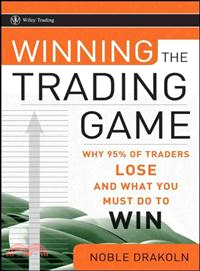| FindBook |
有 1 項符合
WINNING THE TRADING GAME: WHY 95% OF TRADERS LOSE的圖書 |
 |
WINNING THE TRADING GAME: WHY 95% OF TRADERS LOSE 作者:Noble DraKoln 出版社:JOHN WILEY & SONS,LTD 出版日期:2008-03-07 規格: / 284頁 |
| 圖書館借閱 |
| 國家圖書館 | 全國圖書書目資訊網 | 國立公共資訊圖書館 | 電子書服務平台 | MetaCat 跨館整合查詢 |
| 臺北市立圖書館 | 新北市立圖書館 | 基隆市公共圖書館 | 桃園市立圖書館 | 新竹縣公共圖書館 |
| 苗栗縣立圖書館 | 臺中市立圖書館 | 彰化縣公共圖書館 | 南投縣文化局 | 雲林縣公共圖書館 |
| 嘉義縣圖書館 | 臺南市立圖書館 | 高雄市立圖書館 | 屏東縣公共圖書館 | 宜蘭縣公共圖書館 |
| 花蓮縣文化局 | 臺東縣文化處 |
|
|
- 圖書簡介
With Winning the Trading Game, investment expert Noble DraKoln helps you develop and refine the mental discipline and practical skills needed to ensure trading success. This detailed guide will put you in a better position to use technical analysis to identify profitable trades and exit losing trades; maximize the leverage available in futures and Forex, without endangering your capital base; and control risk by utilizing appropriate strategies for each type of opportunity and time frame.
- 作者簡介
Noble DraKoln is President of Liverpool Group Inc., a futures and Forex brokerage firm, where he focuses on the development, management, and promotion of the company's core philosophy of "focusing on the trader not the trading." Prior to this role, DraKoln served as a broker in the retail division of Royal Financial Inc. and as a professional sugar trader. He speaks regularly at industry conferences in the United States and Europe, and has written articles for numerous financial publications. DraKoln is also an NFA Arbitrator and commodities Series 3 licensed.
- 目次
Preface.
Acknowledgments.
Part One. More Life At The End Of Your Money.
Chapter 1. The Need To Build Wealth.
Retiring Early.
Negative Savings Rate.
Social Security.
Conclusion.
Chapter 2. Money-Making Megatrends.
Industrialization.
Emerging Markets.
China.
India.
Brazil.
Russia.
Mexico.
Other Emerging Market Countries.
Resources Under Fire.
Food.
Water.
Energy.
Ethanol The Gasoline Alternative.
Futures, Forex, Or Stocks?
Chapter 3. What Type Of Investor Are You?
Yale Study.
What Are The Returns To Investing In Commodity Futures And How Do These Returns Compare To Investing In Stocks And Bonds?
Are Commodity Futures Riskier Than Stocks?
Can Commodity Futures Provide Diversification To Other Asset Classes?
Pros And Cons.
Types Of Investors.
Type A Investor.
Type B Investor.
Fatal Market Conditions.
Gold And Silver Cornering.
Interest Rate Backfire.
Asian Flu.
Where You Fit In.
Part Two. Why 95% Of Investors Fail At Futures And Forex.
Chapter 4. The World Of Futures And Forex.
Futures And Options.
Hedgers And Speculators.
Futures Exchanges.
What Markets Are Traded?
Foreign Exchange (Forex)
What Is The Spot Market?
Importers And Exporters.
OTC Forex Contracts.
How Is The Spot Price Calculated?
The OTC Participants.
Components Of OTC Contracts.
Types Of Positions And Orders.
Positions.
Types Of Orders.
Options.
Option Rights Vs. Obligations.
Premiums.
Time.
Types Of Options.
Conclusion.
Chapter 5. The Fallacy Of Traditional Stock Investment Beliefs.
Futures And Forex Investing Is Not New.
What You Don't Know Can Hurt You.
Explaining The Strategies.
Buy And Hold.
Dollar Cost Averaging.
Value Investing.
Portfolio Diversification.
Margin.
Don't Short The Market!
Fear Leverage!
Good Use Of Leverage.
Neutral Use Of Leverage.
Bad Use Of Leverage.
Myth Busting.
Chapter 6. How To Be Among The Five Percent Who Win At Trading.
The Reality.
Trading With Emotions.
In The Beginning: Happiness.
Next Comes: Greed.
Followed Up By: Fear.
Which Leads To: Sorrow.
Next You Have: Frustration.
Finally: Defeat.
What The Other 5% Are Doing.
Selecting Trades Properly.
Entering Trades Properly.
Monitoring The Trade.
Exiting The Trade.
Battling The Demons Of Fear And Greed.
Holding Losing Trades.
Chasing Markets.
Overleveraging You Account.
So What It Does It Take To Be A 5% Trader?
Chapter 7. Becoming A Speculator.
Speculation Versus Gambling.
Let's Define Gambling Addiction.
Could Trading Represent A Form Of “Gambling Addiction” For You?
10 Symptoms Of Gambling Addiction.
Seeking Assistance.
The Role Of A Speculator.
Are You A Sucker Or A Speculator?
The Three Keys To Success.
Money Management.
Technical Analysis.
Risk Management.
Using The Keys To Map Out Your Journey.
The Trading Plan.
The Trade Worksheet.
The Trade Journal.
Pulling It All Together.
Part Three. Seven Lessons For Trading Success.
Chapter 8. Lesson 1: Developing A Trading Plan.
Myths Of Trading.
What Markets Should You Trade?
1. Get A Margin Sheet Of All Of The Tradable Markets.
2. Understand Initial Margin And Maintenance Margin.
3. Figure Out Which Markets Have Margins Less Than Your Account.
4. Learn Minimum Tick Or Point Values Of Those Markets.
5. Find Out “Average True Range” To Choose Acceptable Volatility.
6. Organize “Short-Listed” Markets From Least To Most Volatile.
7. Check The “Open Interest” For Each Market To Find The Most Liquid.
What You Have Accomplished.
Chapter 9. Lesson 2: Preparing To Speculate.
Your Money, Your Emotions.
Defining Fear.
Overcoming Fear.
Defining Greed.
Overcoming Greed.
Setting Trading Goals For Yourself.
Why Am I Investing In Futures/Forex?
What Percentage Return Am I Looking For?
When Will I Know If I Have Succeeded?
Money Management Rules.
Your Capital.
Your Account.
Your Trades.
Conclusion.
Chapter 10. Lesson 3: Choosing Your Technical Indicators.
Fundamental Vs. Technical Analysis.
Why Technical Analysis Works.
Technical Analysis Strengths And Weaknesses.
Strengths.
Weaknesses.
Questions For Technical Indicators.
Where Is The Market Going?
How Fast Is It Getting There?
When Has It Arrived?
Liverpool Trader Checklist.
Black Box And Systems Trading.
Chapter 11. Lesson 4: Developing Tactics For Entering And Exiting The Market.
Five Tools For Entry/Exit.
Resistance And Support.
Fibonacci Retracements.
Average True Range.
Moving Average.
Candlestick Patterns.
Trading Is A Team Sport.
Chapter 12. Lesson 5: Analyzing Your Opponents And The Market.
Market Players.
Hedging Examples.
Contango And Backwardation.
Speculators.
Sophisticated Speculators.
Ground Rules For Speculators Using Hedging Techniques As A Risk Management Strategy.
Examples Of Why Hedging Can Be Important.
What Can We Learn?
Analyzing The Markets: Volume, Open Interest, And Liquidity.
Mastering Fundamental Reports.
Tip For Active Traders.
Tip For Swing Traders.
Position Traders.
Conclusion.
Chapter 13. Lesson 6: Managing Risk.
Stock Investment Truisms.
What You Should Believe.
Success And Failure In Trading.
What Makes It Different From Money Management.
Don't Expect A Miracle.
Stops, A Bad Habit.
Power Of The Limit Order.
Determine What Type Of Trader You Are.
Day Trader.
Swing Trader.
Position Trader.
What Risk Management Tools Can Do For You.
9 Risk Management Tactics.
1. Synthetics.
2. Spread Trading.
3. Hard Stops.
4. Covered Option.
5. Hedges.
6. Collars.
7. Straddles.
8. Strangles.
9. Ratio Spreads.
Risk Management Tools Best Suited For Your Trading Style.
Proper Risk Management.
Chapter 14. Building Confidence.
Ten Mistakes All Traders Make.
1. Misuse Leverage.
2. Confuse Speculation With Gambling.
3. Improperly Funding Account.
4. Choosing Costs Over Quality.
5. Misunderstanding The Differences Of Trading.
6. Trading Without A Plan.
7. Not Keeping Records Of Your Trading.
8. Looking For Trading Confirmations.
9. Options Are Not The Only Leveraged Investment.
10. Lack Of Understanding Regarding Money Management.
Demo Accounts And Paper Trading.
Test Account.
Trading Plan, Trade Worksheet, And Trading Journal.
Trading Plan.
Trade Worksheet.
Trading Journal.
Building Confidence Isn't Easy.
Chapter 15. Getting Started (The Three Month Plan).
Four Steps To Seven Lessons.
Money Management.
Technical Analysis.
Risk Management.
Pulling It All Together.
Three Months Of Work.
Month 1: Structure.
Month 2: Trial And Error.
Month 3: Perfecting Your Trading.
What I Want For You As A Trader.
About The Author.
Index.
|











